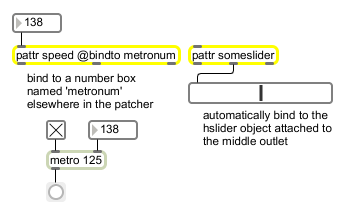| Name |
Type |
g/s |
Description |
| autorestore |
int |
|
Enables (1) or disables (0) the autorestore state of the pattr object. The default is 1 (enabled). When enabled, the pattr object will automatically output its last-saved value when the patcher is loaded (and, if bound to another object, send the value to that object. See the bindto attribute, below for more information on bound objects). |
| bindto |
symbol |
|
The word bindto, which may be followed by an optional symbol argument, sets the pattr object's binding state. The default state is unbound (no arguments). By default, the pattr object maintains its own data. When "bound" using the bindto feature, a pattr object maintains the data for the other object and automatically gets and sets values for that object. bindto takes an optional symbol argument, which specifies the name of the object to which pattr will bind. Binding targets need not be at the same patcher-level as the pattr object. In this case, a double-colon syntax ('::') is used to separate levels of patcher hierarchy for the purposes of describing a path for name resolution (e.g. somepatcher::someobject). If the named object is at a higher patcher-level than the pattr object, the word parent can be used to refer to a patcher at a higher level (e.g. parent::objectaboveme, parent::parent::objectaboveobjectaboveme or parent::patchernexttome::someobject ).
If the named object contains attributes, and the user wishes to bind to a specific attribute, the same double-colon syntax is used to specify the name of that attribute (e.g. someobject::someattribute). A bindto message sent without an argument unbinds the pattr object from any bound object, and causes it to resume the maintenance its own internal state. See the pattr helpfile for more information about this feature. |
| default_active |
int |
|
Enables (1) or disables (0) the pattr object's default active state, when it is discovered by a pattrstorage object. The default is 1 (active). See the Reference for the pattrstorage object for more information. |
| default_interp |
atom |
|
The word default_interp, followed by a symbol and an optional 2nd argument, defines the pattr object's default interpolation setting, when it is discovered by a pattrstorage object. The default is linear. See the Reference for the pattrstorage object for more information. |
| default_priority |
int |
|
The word default_interp, followed by an int, defines the pattr object's default priority, when it is discovered by a pattrstorage object. The default is 0. See the Reference for the pattrstorage object for more information. |
| dirty |
int |
|
Enables (1) or disables (0) the patcher-dirty flag. The default is 0 (disabled). When enabled, the pattr object will dirty the patch whenever its state changes. |
| initial |
atom
def.:
|
|
The pattr object's initial value. If autorestore is set to 1, this value will be restored upon patch load, rather than the value of the pattr object at the time the patch was last saved. The initial attribute can be used in combination with the init message to reset the pattr object to the specified value. |
| invisible |
int |
|
The word invisible, followed by a 1 or 0, determines whether or not the pattr object is invisible to pattrstorage objects. The default is 0 (visible). |
| parameter_enable |
int |
|
Enables parameter support. |
| thru |
int |
|
Enables (1) or disables (0) the pattr object's thru behavior. The default is 1 (enabled). When enabled, the object will output its value whenever it changes. When disabled, the object will only output its value when it receives a bang message. |
| type |
symbol |
|
The word type, followed by a symbol corresponding to a valid type, sets the data type maintained internally by the pattr object, when the object is not bound. The default is atom. Available types include char, long, float32, float64, symbol, and atom. |

